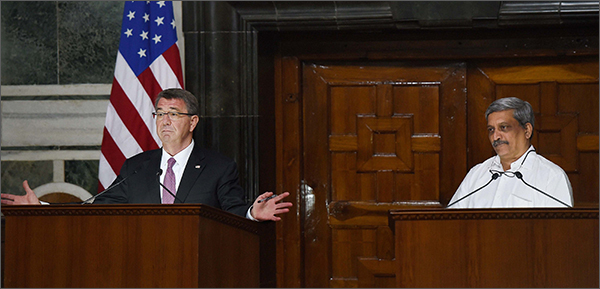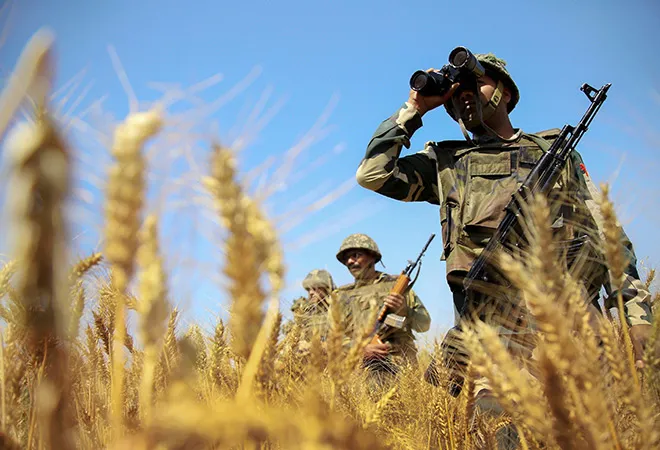On an ordinary globe, India and the United States cannot be seen together, so far apart are they that when it’s daylight here it is night there. Yet, preachy, noisy democracies have a strange pull for each other. They now say that they are in the process of establishing a strategic relationship, which the cheerleaders declare will be the defining partnership of the 21st century. The facts on the ground suggest, however, that both sides continue to hedge and the framework of the relationship remains somewhat rickety.
The US is pressing India to sign a number of what it calls “foundational agreements” to operationalise India’s military commitments implicit in the Joint Strategic Vision for Asia-Pacific and the Indian Ocean arrived at during President Barack Obama’s visit to New Delhi in January 2015. Following the recent visit of US Defence Secretary Ashton Carter, it was announced that the two sides were close to signing a logistics support MoU, one of a raft of technical agreements aimed at bringing the militaries of the two sides to the point where they can operate together seamlessly.

There is, clearly, in the case of the US, a disconnect between the almost brash Pentagon wooing of India and the more sophisticated approach of the US Department of State, which says that the very existence of a stronger and economically vibrant India will serve US interests.
From the Indian point of view, there is another disconnect — between US eagerness for Indian participation in action in the South China Sea, and its lukewarm approach to an Indian connection in Afghanistan or, for that matter, the Persian Gulf and the Saudi peninsula.
Technically, the Joint Strategic Vision ought to cover the region, but the reality is that India is dealt with in the US politico-military system by the Pacific Command, headquartered in Hawaii, and whose responsibilities extend up to Diego Garcia. Beyond that, the Central Command, headquartered in Florida, “looks after” the Persian Gulf, Central Asia, Afghanistan and Pakistan. When we do military cooperation, the Indian Ocean does not quite include the northern Arabian Sea and the Persian Gulf.
However, both from the geo-economic and geo-strategic view, this is the most important external region for India’s security. We source 70% of our oil from there, and 7 million Indian citizens working there send back $30 billion in remittances. As our energy needs increase, this area will only become more important. In the past, we have had to carry out large-scale evacuations of our nationals because of war-like situations in this region, most recently from Yemen in 2015.
The prognosis for the stability of the whole region is not particularly good. Yet, somehow, there are no drills, joint exercises or planning between the US, which is the dominant power, with a fleet headquartered in Bahrain, and India for conflict contingencies. It is a bit odd that all the exercises and activities take place in the east, which is largely stable and peaceful and none in the area may actually require cooperative military action. Whereas in East Asia, we are building trilateral partnerships with the US and its other partners like Japan, Australia and South Korea, in the Persian Gulf and Saudi peninsula, we appear to be ploughing a lonely furrow.

Given the rapid rise of China and our own considerable difficulties with Beijing, having the US as a security partner is useful. With its million-man army and nuclear weapons, India does not really need the US for its existential security, certainly not from any direct threat from China. But, we do need partnerships and coalitions to enable us to maintain a secure periphery that includes a region which will literally provide the fuel for it.
The US, for its part, wants India to play a role in creating a balance of power to keep China in check in East Asia. China may be well ahead of India in almost all measures of what is called comprehensive national power. But, India is the only country in Asia that can offset the massive gravitational pull of China. Yet, beyond the need to have open sea lanes in the South China Sea, India has little or no interest in facing off with Beijing in the area. Given its huge external trade, the biggest loser from any disruption would be China itself.
The success of a sound India-US partnership is to clearly think through some of these issues. The trick is not to be overwhelmed by rhetoric and keep national interest firmly in mind. The US, let’s be clear, is seeking Indian friendship to maintain its primacy in the world system. India, in turn, needs the US as a guarantor of a secure and stable world system, but especially as a security provider in the Persian Gulf region, where we have no military capacity.
So, while the overall tenor of our relationship is excellent and we have growing convergence in East Asia, there is need to focus on the huge gap that exists in relation to the most vital area of our external interest.
This commentary originally appeared in The Indian Express.
The views expressed above belong to the author(s). ORF research and analyses now available on Telegram! Click here to access our curated content — blogs, longforms and interviews.






 PREV
PREV


